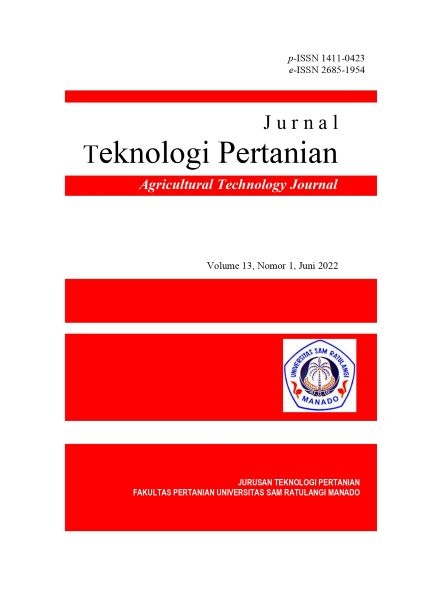Utilization of purple yam skin (Ipomoea batatas L.) in the making of nata de batatas
DOI:
https://doi.org/10.35791/jteta.v13i1.50268Keywords:
nata de batatas, purple sweet potato skin, coconut water, anthocyaninAbstract
Nata de batatas is a product of purple sweet potato peel. The presence of anthocyanin compounds in purple sweet potato skin makes this food very attractive to be processed into nata products that have functional value. The purpose of this research was to determine the yield of nata from purple sweet potato peel made with variations in the percentage of purple sweet potato peel extract and the percentage of coconut water and pellicle thickness, evaluate organoleptic properties including texture, color, aroma, taste, and determine anthocyanin levels. The results showed that the highest nata yield was 70.08%. The thickness of the largest 1.26 cm. The best anthocyanin analysis in nata was 0.47 mg. The organoleptic test showed that the color percentage of purple sweet potato peel extract and the percentage of coconut water were significantly different while the texture, aroma and taste were not significantly different.
Keywords: nata de batatas, purple sweet potato skin, coconut water, anthocyanin
References
Agung. 2012. Ekstraki Antosianin dari Limbah Kulit Ubi Jalar Ungu (Ipomea batatas) Metode Microwave Assisted Extraction (Kajian waktu Ekstraksi dan Rasio Bahan; Pelarut). Skripsi. Malang Jurusan THP FTR -Universitas Brawijaya.
Alwi, M., Rahmiati, R., & Umrah, U. (2011). Pemanfaatan Limbah Cair Tahu (Whey Tahu) Sebagai Media Tumbuh Acetobacter xylinum untuk Memproduksi Nata. 5(2): 91-98.
Amiarsi, D., A. B. Arif, A. Budlyanto, dan W. Diyono. 2015. Analisis parametrik dan non parametrik pengaruh konsentrasi sukrosa dan ammonium sulfat terhadap mutu nata de melon. Jurnal informatika pertanian. 24 (1): 101-108.
Charley, H. 1970. Food Science. Jhon Willey and Sons Inc. New York.
Dipu, Y. Hastuti. U. Gofur. A. 2016. Pengaruh Macam Gula terhadap Kualitas Yoghurt Kacang Buncis (Phaseolus vulgaris) Varietas Jimas Berdasarkan Hasil Uji Organoleptik, Proceeding Biology Education Conference, Vol. 13, No. 1 hal 857-862.
Giusti M. M, Wrolstad R. E. 2001. Unit F1.2: Anthocyanins. Characterization and Measurement with UV - Visible Spectroscopy. In: Wrolstad, RE, editor. Current Protocols in Food Analytical Chemistry. New York: John Wiley & Sons. p. F1.2.1–1.2.13
Iryandi, Anhar F. 2014. Pengaruh Air Jeruk Nipis (Citrus aurantifolia) dan Lama fermentasi terhadap karakteristik Nata De soya. Jurnal Bioproses komoditas tropis Vol. 1 No. 1Hal 8-15. Fakultas Teknologi Pertanian. Universitas Briwijaya. Malang.
Lempang M. 2006. Rendemen dan Kandungan Nutrisi Nata Pinnta Yang Diolah dari Nira Aren. Jurnal Penelitian Hasil Hutan 24(2): 133-144.
Majesty, J., B.D. Argo, dan W.A. Nugroho. 2015. Pengaruh penambahan sukrosa dan lama terhadap kadar serat nata dari sari nanas (nata de pina). Jurnal Keteknikan Pertanian Tropis dan Biosistem 3(1):80-85.
Naufalin R dan Wibowo C. 2004. Pemanfaatan hasil samping pengolahan tepung tapioka untuk pembuatan nata de cassava: kajian penambahan sukrosa dan ekstrak kecambah. Jurnal Teknologi Industri Pangan. 15 (2): 153-158.
Suda, I., T. Oki, M. Masuda, M. Kobayashi, Y. Nishiba, and S.Furuta. 2003. Physiological functionality of purple-fleshed sweet potatoes containing anthocyanins and their utilization in foods. JARQ 37 (3): 167-17.
Suzery, M., Lestari L., Cahyono, B., 2010 Jurnal Sains & Matematika (JSM) Penentuan total antosianin dari kelopak bungan Rosela (Hibiscus sabdariffa l) dengan metode maserasi dan sokshletasi, Volume 18, No. 1.
Downloads
Published
Issue
Section
License
Copyright (c) 2022 Fahira Gafar, Yoakhim Y.E. Oessoe, Jolanda Ch.E. Lamaega

This work is licensed under a Creative Commons Attribution-ShareAlike 4.0 International License.


 Journal Template
Journal Template


